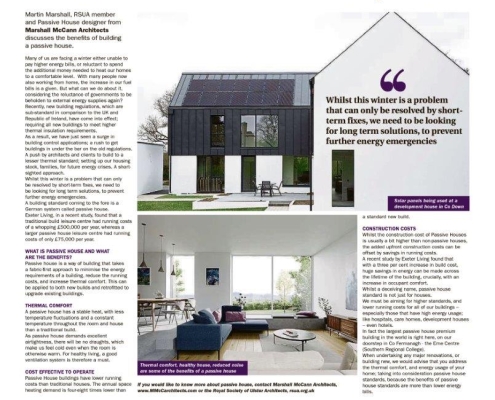With the cost of living crisis, is the future of homes already here?
(As printed in The Irish News)
Many of us are facing a winter either unable to pay higher energy bills, or reluctant to spend the additional money needed to heat our homes to a comfortable level. With many people now also working from home, the increase in our fuel bills is a given. But what can we do about it, considering the reluctance of governments to be beholden to external energy supplies again?
Recently, new building regulations, which are sub-standard in comparison to UK & ROI, have come into effect; requiring all new buildings to meet higher thermal insulation requirements. As a result, we have just seen a surge in Building Control applications; a rush to get buildings in under the bar on the old regulations. A push by architects and clients to build to a lesser thermal standard; setting up our housing stock, families, for future energy crises. A short-sighted approach.
Whilst this winter is a problem that can only be resolved by short-term fixes, we need to be looking for long term solutions, to prevent further energy emergencies.
A building standard coming to the fore is a German system called Passive House.
Exeter Living, in a recent study, found that a traditional build Leisure Centre had running costs of a whopping £500k/year, whereas a larger Passive House Leisure Centre had running costs of only £75k/year.
WHAT IS PASSIVE HOUSE & WHAT ARE THE BENEFITS?
Passive House is a way of building that takes a ‘fabric-first’ approach to minimise the energy requirements of a building, reduce the running costs, and increase thermal comfort. This can be applied to both new builds and retrofitted to upgrade existing buildings.
THERMAL COMFORT
A passive house has a stable heat, with less temperature fluctuations and a constant temperature throughout the room & house than a traditional build.
As Passive House demands excellent airtightness, there will be no draughts, which make us feel cold even when the room is otherwise warm. For healthy living, a good ventilation system is therefore a must.
COST EFFECTIVE TO OPERATE
Passive House buildings have lower running costs than traditional houses. The annual space heating demand is 4-8 times lower than a standard new build.
CONSTRUCTION COSTS
Whilst the construction cost of Passive Houses is usually a bit higher than non-passive houses, the added upfront construction costs can be offset by savings in running costs. A recent study by Exeter Living found that with a 3% increase in build cost, huge savings in energy can be made across the lifetime of the building, crucially, with an increase in occupant comfort.
Whilst a deceiving name; Passive House Standard is not just for houses. We must be aiming for higher standards, and lower running costs for all of our buildings – especially those that have high energy usage; like hospitals, care homes, development houses – even hotels. In fact; the largest Passive House Premium building in the world is right here, on our doorstep in Co. Fermanagh – The Erne Centre (Southern Regional College).
When undertaking any major renovations, or building new, we would advise that you address the thermal comfort, and energy usage of your home; taking into consideration Passive House Standards; because the benefits of Passive House standards are more than lower energy bills.
If you would like to know more about Passive House, please contact us: info@MMcCArchitects.com
Martin Marshall, Passive House Designer


 Marshall McCann Architects
Marshall McCann Architects